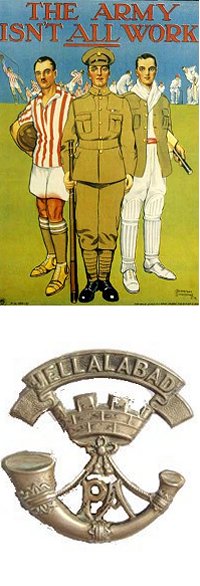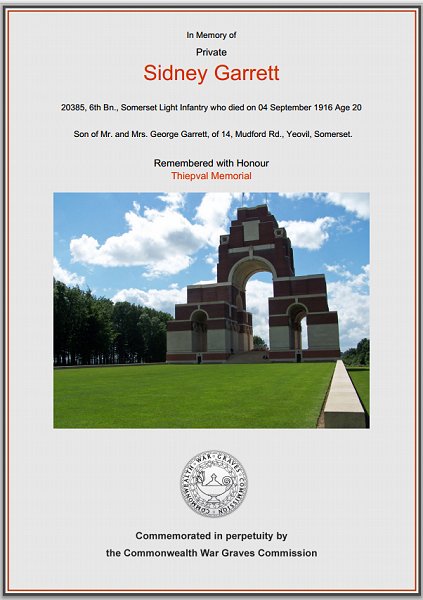yeovil at War
Sidney Garrett
Killed in action in Flanders
Sidney G Garrett was born in 1896 in Yeovil, the youngest of the five children of glove cutter George Garrett (1858-1944) and Mary Jane née Ham (b 1860). In the 1901 census five-year old Sidney was listed living at 33 Vicarage Street with his parents and siblings - all of whom were in the gloving trade. By the time of the 1911 census George and Mary had moved to 14 Vincent Place with three of their children (they had a total of seven children but two had died in infancy). George now gave his occupation as an Engineer's labourer while 14-year old Sidney listed his occupation as a hairdresser.
 Although
it is not known
exactly when,
Sidney enlisted
at Yeovil and
joined the 6th
(Service) Battalion,
Somerset Light
Infantry that
was formed in
August 1914. His
Service Number
was 20385,
hinting that he
enlisted early
in 1916.
Although
it is not known
exactly when,
Sidney enlisted
at Yeovil and
joined the 6th
(Service) Battalion,
Somerset Light
Infantry that
was formed in
August 1914. His
Service Number
was 20385,
hinting that he
enlisted early
in 1916.
During 1916 the 6th Battalion fought in the trenches of the Western Front and in this year were involved in the action at Delville Wood in the Battles of the Somme.
Delville Wood is to the north east of the town of Longueval in the département of the Somme in northern France.
After the two weeks of carnage from the commencement of the Somme Offensive, it became clear that a breakthrough of either the Allied or German line was most unlikely and the offensive had evolved to the capture of small prominent towns, woods or features which offered either side tactical advantages from which to direct artillery fire or to launch further attacks.
Delville Wood was one such feature, making it important to German and Allied forces. As part of a large offensive starting on 14 July, General Douglas Haig, Commander of the British Expeditionary Force, intended to secure the British right flank, while the centre advanced to capture the higher lying areas of High Wood in the centre of his line. Delville Wood was a battle to secure this right flank. The battle achieved this objective and is considered a tactical Allied victory. However, it was one of the bloodiest confrontations of the Somme, with both sides incurring large casualties.
According to the Regimental History of the Somerset Light Infantry, after the first phase of the Battle of Delville Wood, the 6th Somersets had spent several days in billets in Fricourt. During August the battalion was involved in the taking of Hop Alley and Beer Trench adjoining Delville Wood. After much heavy fighting the whole of Hop Alley passed into the hands of the Somerset men. Following the fighting, according to the Regimental History, "They dug a new CT (communication trench) under heavy fire and did it quickly and well. Also carried wire, stakes, etc, to the front line. Sent back 82 prisoners under escort. Carried bombs and sandbags. Put up artillery boards. Sent 20 men to fill gap on our left. Sent 20 men to make and hold a strong point in gap between right companies. Sent 30 men to support C company in Hop Alley. And then, when night had fallen, the remainder of this gallant company carried bombs, SAA, water, etc. to the front line."
The Regimental History continues "A little later (at 5pm) officers of the 9th Rifle Brigade came to look round the trenches of the 6th Somersets and made arrangements for taking them over. Hostile shelling, however, prevented the relief taking place until almost midnight, but this was all to the advantage of the Somerset men, who had no casualties in coming out of the line. The relief was completed at 4:15am, the battalion being billeted in Fricourt. "The men," stated the Battalion Diary, "on arrival in rest billets, were absolutely beat; the authorities had wisely kept them until the last possible moment and then taken them out." Thus ended another phase of the Battle of Delville Wood, a phase which cost the regiment five officers killed and seven wounded, with 48 other ranks killed and 220 wounded and missing. On 22 August the Brigade was paraded and the Brigadier complimented the 6th Somersets especially on the fine behaviour of the Battalion in Delville Wood."
On 26th August the 6th Battalion moved forward again to reserve trenches 300 yards in front of Bernafay Wood. Relief, however, came on 30 August, the 6th Somersets returning first to temporarily billets in Fricourt and then to a rest camp. On 31 August the Battalion entrained at Mericourt for Selincourt, 20 miles west of Amiens where, until 12 September, all ranks enjoyed a complete rest.
However, according to the letter quoted below in the report of the Western Gazette, it appears that on 4 September 1916 Sidney was at Ginchy, 28 miles (45km) northeast of Amiens. Where he was wounded and was last seen making his way to a field dressing station. It is assumed that he died on this day. He was aged 20.
On 17 February 1917, the Western Gazette reported "Mr and Mrs G Garrett, of 37 King Street, Goldcroft, have received a letter from the Enquiry Department for Wounded and Missing of the British Red Cross and Order of St John respecting their youngest son, Private Sidney Garrett of the Devons (sic), stating that they had not been able to find any definite information about Private Garrett up to the present. The only report they had received was one from Private TG Miller, of the same company and battalion, stating that he last saw Private Garrett on September 4th at Ginchy in their lines. He had been wounded, but was able to walk, and was on his way to the dressing station. He added that there was heavy firing going on at the time. They greatly feared that Private Garrett must have met with some further disaster after he was seen by Private Miller, but were continuing their enquiries on the parents’ behalf in order to obtain further details."
As a sidenote it is interesting that the Western Gazette referred to Sidney being "of the Devons". I have not yet been able to establish if the Devons were at Ginchy in September but it is unlikely that Sidney was transferred between regiments at this time.
Sidney Garrett is commemorated on Pier and Face 2A of the Thiepval Memorial, and his name is recorded on the War Memorial in the Borough.
gallery

The Commonwealth War Graves Commission certificate in memory of Sidney Garrett.